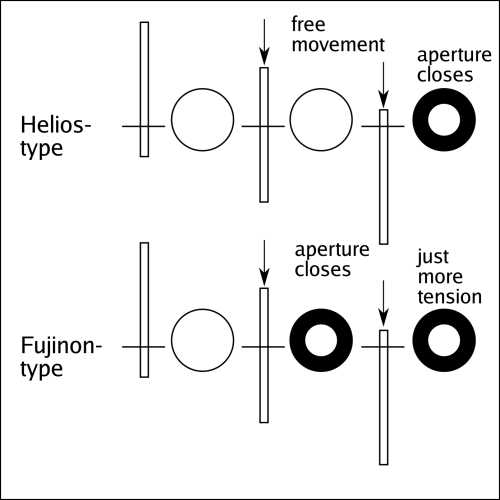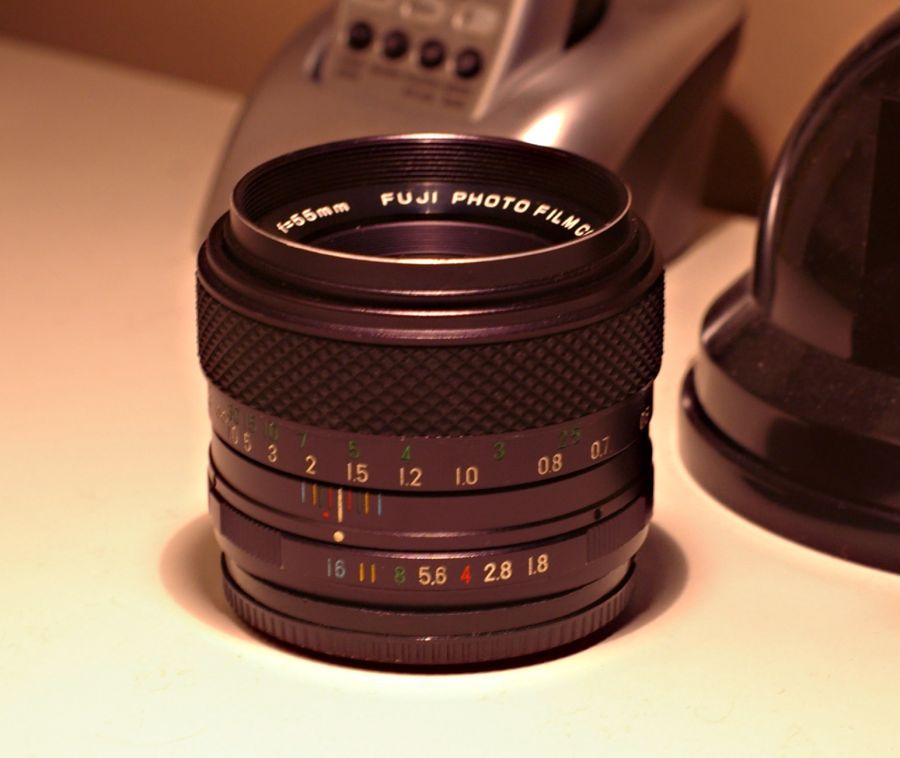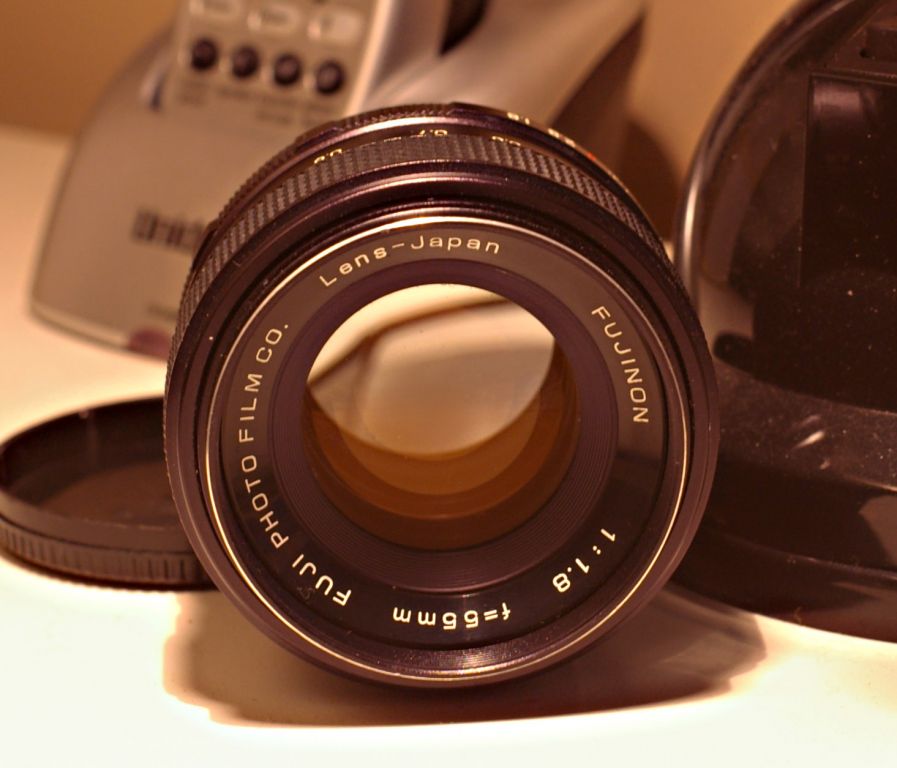| View previous topic :: View next topic |
| Author |
Message |
Univer

Joined: 30 Jun 2009
Posts: 282
|
 Posted: Tue Oct 06, 2009 7:42 pm Post subject: M42 Fujinon Questions Posted: Tue Oct 06, 2009 7:42 pm Post subject: M42 Fujinon Questions |
 |
|
Univer wrote:
Hi All,
After several decades of using M42 glass, I recently had my first hands-on experience with M42 Fujinon lenses. That experience has left me with a few questions, and I'm hoping the experts here might be able to enlighten me.
I am the new owner of an EBC 28mm 3.5 and a 55mm Fujinon 1.8; the 55 seems to be identical in most respects to the EBC version, but it is not so marked. It has the little locking notch on the mount, as well as the protruding lug on the aperture ring.
Unfortunately, this lens will not stop down, no matter how the aperture pin and aperture ring are manipulated. There is lively spring pressure on the aperture pin. Has anyone encountered this fault among Fujinons, or do you suppose someone might have performed some sort of surgery on this specimen?
Also with regard to this lens: I was very happy to find Arkku's instructions for converting a Fujinon lens to manual operation (thank you, Arkku!), because he carefully explained the procedure for removing the aperture ring; I thought I might be able to get inside the lens to see what the stop-down problem might be. Then I read further, and learned that the 55 1.8 is an exception to the "normal" disassembly procedure. I was wondering - has anyone made any progress with respect to disassembling this particular lens?
Finally, a general question. I dimly recall, from years ago, an admonition not to try to use EBC lenses on non-Fujica bodies. I assume this has to do with the aperture-ring lug. Based on a quick eyeball evaluation, it looks like that little lug would be very likely to drop itself into one of the slots in my M42->K adapter and lodge there. What is the recommended procedure for dealing with that problem - careful grinding off of the lug? And are there any other possible incompatibilities I should be aware of?
Many thanks for your help!
Cheers,
Jon |
|
| Back to top |
|
 |
indianadinos


Joined: 06 Jul 2008
Posts: 1310
Location: Toulouse, France
Expire: 2011-12-05
|
 Posted: Tue Oct 06, 2009 8:13 pm Post subject: Posted: Tue Oct 06, 2009 8:13 pm Post subject: |
 |
|
indianadinos wrote:
Hi Jon,
I'm afraid i cannot help too much with your Fujinons ...
The only M42 Fujinon lens i have is a 55/1.8, which is an "auto" only lens. But, instead of modding it, i have preferred to buy an M42-to-P/K adapter with an inner flange to keep the diaphragm pin pushed ...
It is a bit more expensive solution than the one with the cotton swab, but i didn't have to open the lens (moreover, i have never find a tutorial on how to service this lens), and the adapter works like a charm with my auto Biotar too  ... ...
If interested, i bought it from Alex (hk300 on this forum), but i think Attila too sells them ...
Cheers
_________________
Please visit my blogs Shooting with a Pentax K10D / FF Visions
Takumar: 24/3.5, 28/3.5, 35/2, 35/3.5, 50/1.4, 55/1.8, 85/1.8, 105/2.8, 120/2.8, 135/3.5, 150/4, 200/4
Pentax-K: M28/2.8, K28/3.5, M50/1.4, A50/1.7, M50/4 Macro, K85/1.8, K105/2.8, K135/2.5, M200/4, M70-150/4
Zeiss: Flektogon 20/2.8, 20/4, 35/2.4, 35/2.8, Tessar 50/2.8, Pancolar 50/1.8, Biotar 58/2, Sonnar 135/3.5, Sonnar 180/2.8
Meyer: Primagon 35/4.5, Domiplan 50/2.8, Oreston 50/1.8, Primoplan 58/1.9, Trioplan 100/2.8, Orestor 100/2.8, Orestor 135/2.8
Schacht/Steinheil: Travenar 90/2.8, Travenon 135/4.5, Quinar 135/2.8, Quinar 135/3.5
Russian: MIR 37B, Industar 50/3.5, Helios 44M & 44M-2, Jupiter 37A
P6: Flektogon 50/4, Biometar 80/2.8, Orestor 300/4
Nikkor: Nikkor-O 35/2, Micro 55/3.5, Nikkor-S 50/1.4, Nikkor-Q 135/2.8
Fuji: EBC 28/3.5, EBC 55/3.5 Macro, EBC 135/2.5
Misc Lenses: Kiron 105/2.8 Macro, Tamron SP90/2.5
... and a few other Vivitar, Tamron, Sigma and Soligor lenses ...
|
|
| Back to top |
|
 |
Univer

Joined: 30 Jun 2009
Posts: 282
|
 Posted: Thu Oct 08, 2009 1:29 am Post subject: Posted: Thu Oct 08, 2009 1:29 am Post subject: |
 |
|
Univer wrote:
Hi,
Thanks so much for the reply. As it happens, I have one of Alex's flanged adapters, and I've been very pleased with it. I plan to use it, in fact, with the 28mm EBC Fujinon, once I grind off the problematic aperture-ring lug.
As for the 55mm, I suppose it's destined to be a wide-open-only lens, unless I can {a} figure out how to open it up and {b} repair it once I do. I really do think someone may have deliberately disabled the aperture mechanism - for some reason I can't begin to guess.
Cheers,
Jon |
|
| Back to top |
|
 |
mo


Joined: 27 Aug 2009
Posts: 8979
Location: Australia
Expire: 2016-07-30
|
 Posted: Thu Oct 08, 2009 1:52 am Post subject: Posted: Thu Oct 08, 2009 1:52 am Post subject: |
 |
|
mo wrote:
Could you post a shot of the 55/1.8 fuji mount as I have one which does not have the notch,I am wondering has it been modified?
_________________
Moira, Moderator 
Fuji XE-1,Pentax K-01,Panasonic G1,Panasonic G5,Pentax MX
Ricoh Singlex TLS,KR-5,KR-5Super,XR-10
Lenses
Auto Rikenon's 55/1.4, 1.8, 2.8... 50/1.7 Takumar 2/58 Preset Takumar 2.8/105 Auto Takumar 2.2/55, 3.5/35 Super Takumar 1.8/55...Macro Takumar F4/50... CZJ Biotar ALU M42 2/58 CZJ Tessar ALU M42 2.8/50
CZJ DDR Flektogon Zebra M42 2.8/35 CZJ Pancolar M42 2/50 CZJ Pancolar Exakta 2/50
Auto Mamiya/Sekor 1.8/55 ...Auto Mamiya/Sekor 2/50 Auto Mamiya/Sekor 2.8/50 Auto Mamiya/Sekor 200/3.5 Tamron SP500/8 Tamron SP350/5.6 Tamron SP90/2.5
Primoplan 1.9/58 Primagon 4.5/35 Telemegor 5.5/150 Angenieux 3.5/28 Angenieux 3,5/135 Y 2
Canon FL 58/1.2,Canon FL85/1.8,Canon FL 100/3.5,Canon SSC 2.8/100 ,Konica AR 100/2.8, Nikkor P 105/2.5
|
|
| Back to top |
|
 |
Univer

Joined: 30 Jun 2009
Posts: 282
|
 Posted: Thu Oct 08, 2009 8:10 pm Post subject: Posted: Thu Oct 08, 2009 8:10 pm Post subject: |
 |
|
Univer wrote:
Hi,
Happy to oblige - I'll post a photo this weekend.
Cheers,
Jon |
|
| Back to top |
|
 |
kansalliskala


Joined: 19 Jul 2007
Posts: 5044
Location: Southern Finland countryside
Expire: 2016-12-30
|
 Posted: Fri Oct 09, 2009 7:10 am Post subject: Posted: Fri Oct 09, 2009 7:10 am Post subject: |
 |
|
kansalliskala wrote:
I think it might be impossible to easily fix Fujinons because the mechanism is slightly different. Can't check it anymore because sold my Fujinons.
Here is a diagram for checking what type it is.
EDIT: Helios means 44M here
EDIT 2: OK, I usually read these messages before answering. I had EBC 55/1.8 and it opened from the front, not rear ..

_________________
MF: Kodak DCS SLR/c; Samsung NX10; OM-10; Canon T50
Zuiko 28/3.5, Distagon 35/2.8; Yashica ML 50/2;
Zuiko 50/1.4; S-M-C 120/2.8; Zuiko 135/3.5; 200/5;
Tamron AD1 135/2.8, Soligor 180/3.5; Tamron AD1 300/5.6
Tamron zooms: 01A, Z-210
Yashicaflex C; Київ 4 + Юпитер 8, 11; Polaroid 100; Olympus XA; Yashica T3
Museum stuff: Certo-Phot; Tele-Edixon 135; Polaris 90-190; Asahi Bellows; Ixus IIs
Projects: Agfa Isolette III (no shutter), Canon AE-1D (no sensor),
Nikon D80 (dead), The "Peace Camera"
AF: Canon, Tokina, Sigma Video: JVC GZ-MG275E |
|
| Back to top |
|
 |
Univer

Joined: 30 Jun 2009
Posts: 282
|
 Posted: Wed Oct 14, 2009 1:47 pm Post subject: Posted: Wed Oct 14, 2009 1:47 pm Post subject: |
 |
|
Univer wrote:
Thanks, all, for the very helpful replies. And profound apologies for returning to this thread later than I had intended.
The attached photos - quick snaps on a crowded desk, and imperfectly focused - hopefully show the mount and overall design of the 55 1.8 Fujinon about which I inquired originally.
The first photo shows the mount, with the little lug protruding from the aperture ring highlighted. Since the lug is perfectly placed to lodge irretrievably in the slots of my M42->PK adapter, I expect that I will be using a Dremel to remove it. Not visible in this shot is the little cut-out for the locking catch.



Photos 2 and 3 are intended to show the construction and styling of the lens. To my eye, this lens looks identical to the EBC Fujinon series - except for the fact that the "EBC" designation is missing from the beauty ring.
I had always associated the problematic aperture-ring lug with the EBC lenses, but that is clearly incorrect. Does anyone happen to know: is it the case that the new styling (and aperture lug) preceded the introduction of the EBC series, or is it the case that some early EBC lenses did not receive the "EBC" designation? (I'm wondering, in other words, whether this might be a parallel to the introduction of the SMC coating, prior to the formal adoption of the SMC nomenclature, on some of the late Super-Takumars.)
Anyway - unless I can figure out and correct this particular example's aperture problem, it is destined to be a wide-open-only lens.
Cheers,
Jon |
|
| Back to top |
|
 |
mo


Joined: 27 Aug 2009
Posts: 8979
Location: Australia
Expire: 2016-07-30
|
 Posted: Wed Oct 14, 2009 8:48 pm Post subject: Posted: Wed Oct 14, 2009 8:48 pm Post subject: |
 |
|
mo wrote:
Just for comparison here is my Fujinon 1:1.8/55
No lug and no evidence of one being removed,the iris only closes when I push the pin in.



_________________
Moira, Moderator 
Fuji XE-1,Pentax K-01,Panasonic G1,Panasonic G5,Pentax MX
Ricoh Singlex TLS,KR-5,KR-5Super,XR-10
Lenses
Auto Rikenon's 55/1.4, 1.8, 2.8... 50/1.7 Takumar 2/58 Preset Takumar 2.8/105 Auto Takumar 2.2/55, 3.5/35 Super Takumar 1.8/55...Macro Takumar F4/50... CZJ Biotar ALU M42 2/58 CZJ Tessar ALU M42 2.8/50
CZJ DDR Flektogon Zebra M42 2.8/35 CZJ Pancolar M42 2/50 CZJ Pancolar Exakta 2/50
Auto Mamiya/Sekor 1.8/55 ...Auto Mamiya/Sekor 2/50 Auto Mamiya/Sekor 2.8/50 Auto Mamiya/Sekor 200/3.5 Tamron SP500/8 Tamron SP350/5.6 Tamron SP90/2.5
Primoplan 1.9/58 Primagon 4.5/35 Telemegor 5.5/150 Angenieux 3.5/28 Angenieux 3,5/135 Y 2
Canon FL 58/1.2,Canon FL85/1.8,Canon FL 100/3.5,Canon SSC 2.8/100 ,Konica AR 100/2.8, Nikkor P 105/2.5
|
|
| Back to top |
|
 |
|
|
|
You cannot post new topics in this forum
You cannot reply to topics in this forum
You cannot edit your posts in this forum
You cannot delete your posts in this forum
You cannot vote in polls in this forum
|
